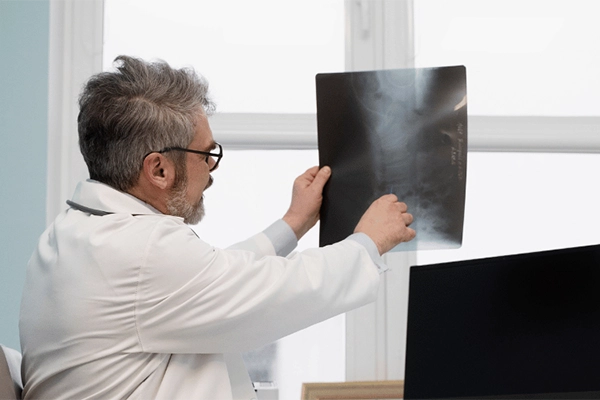Topics
Bad posture refers to a misalignment of different parts of the body in relation to gravity, leading to undue strain on muscles, ligaments, and joints. It is a prevalent issue in modern society due to long hours of sitting, using digital devices, and lack of physical activity.
What are the signs of bad posture?
Here are some signs of a bad posture:
- Rounded shoulders
- Uneven hips or shoulders
- Slouching or hunching forward
- Head tilted forward
- Development of a potbelly
- Arching back leading to pain or other spinal issues
- Muscle fatigue
- Recurring headaches
- Frequent body aches
- Poor balance and coordination
What are the different types of bad posture?
The following are some common types of bad postures:
- Flat back: The lower back flattens out in this posture, losing the spine's natural curvature. This is mainly due to muscle weakness, causing the spine to appear flatter than usual. People with flat backs have trouble standing for a long time and often tend to stoop forward.
- Hunchback (Kyphosis): This is an exaggerated rounding of the upper back caused by weak back muscles, poor posture, or spinal conditions such as osteoporosis.
- Anterior pelvic tilt: The pelvis is tilted forward, leading to an exaggerated arch in the lower back. As a result, you may experience hip flexor tightness and pain in your lower back.
- Swayback (Lordosis): This is a combination of anterior pelvic tilt and hunched upper back, which can cause pain in the lower back, neck, and shoulders.
- Forward head: This is characterised by the head being positioned too far forward in relation to the shoulders, which can strain the neck and upper back muscles.
What are the impacts of bad posture?
Some of the impacts of a bad posture are:
- Back and neck pain: When you slouch or hunch over, it puts extra strain on your spine, leading to pain in your lower back, upper back, or neck.
- Shoulder pain: Slouching and hunching put stress on the shoulder and neck muscles, causing pain and discomfort.
- Headaches: Due to the strain on the neck and shoulders, slouching can lead to tension headaches. Moreover, this might trigger migraines and other types of headaches.
- Decreased lung function: Slouching can reduce the space available for your lungs to expand, resulting in shallow breathing and decreased lung function.
- Heartburn and slowed digestion: A slouched posture after a meal may precipitate heartburn caused by acid reflux.
- Chronic disability: Over time, slouching or slumping can make the spine weaker and more prone to injury.
- Fatigue: Poor posture can make you feel more tired and less energised as it requires more effort for your body to maintain a balanced posture, which may drain your energy.
What are the steps to correct bad posture?
- 1. How to improve bad sitting posture?
To improve your sitting posture, practice the following more frequently:
- Get up and move around every 30 minutes to help stretch your spine as well as the muscles surrounding it.
- Use a supportive chair when seated to prevent slouching.
- Use a stool or footrest to raise your feet higher to prevent slouching and to relax the muscles in your lower spine.
- 2. How to improve bad standing posture?
To improve your standing position, practice the following more frequently:
- Maintain your feet shoulder-width apart and evenly distribute your weight on both feet.
- Engage your core to support your spine and maintain its neutral position.
- Avoid forward and backward head tilting by keeping your chin parallel to the ground.
- Relax your shoulders, pull your shoulder blades back and down towards your spine.
- Avoid prolonged standing in the same position.
- Regularly stretching your neck, shoulders, and back will relieve tension and increase flexibility.
- Wear comfortable footwear to avoid long-term posture issues.
- Keep yourself active throughout the day by taking short walks and doing physical activities.
- 3. How to improve bad sleeping posture?
Sleeping in an improper position for a long time can stress your shoulders and neck muscles, leading to pain and discomfort. To improve your standing position, practice the following more frequently:
- Sleep on the side with a pillow between the knees.
- Use supportive pillow.
- Ensure your spine is aligned in a neutral position.
- Avoid sleeping with your arms above your head.
- Use supportive mattress.
- Gently stretch before sleeping.
- 4. How to improve bad driving posture?
- Ensure your seat is positioned at the right height and distance from the steering wheel. Your knees should be bent at a 90-degree angle, and your feet should be able to easily reach the pedals.
- Sit straight with your shoulders back and your head aligned with your spine.
- Add a lumbar support cushion.
- Adjust your mirrors so you do not strain your neck or back to view them.
- Strengthen your core muscles by regularly exercising.
FAQs on bad posture
-
Does bad posture cause scoliosis?
In most cases, scoliosis is congenital or caused by neuromuscular conditions resulting in improper development of the vertebrae.
However, bad posture can contribute to the progression of scoliosis and exacerbate its symptoms. This can lead to spinal misalignments and put pressure on the already curved spine in scoliosis patients.
-
Is bad posture permanent?
No, bad posture is not a permanent condition. However, it can become a habit that is difficult to break without proper intervention.
With the right approach, it is possible to improve your posture and prevent further damage to your body. This may involve a combination of exercises and lifestyle modifications, such as practising good ergonomics, maintaining a healthy weight, and taking breaks from sitting for an extended period of time.
Speak to an orthopaedic specialist to learn more about preventing bad posture.
-
Does bad posture stunt growth?
Having a bad posture does not change the structure of one's bones. However, a person with a hunched back posture and rounded shoulders might appear shorter than his/her actual height.
Make an appointment at Pantai Hospitals
Good posture entails more than simply standing up to look your best. It plays an integral part in your long-term health.
A dedicated and expert team of Orthopaedic specialists at Pantai Hospital is available for consultation to provide the best care possible.
Get in touch with us to book an appointment today if you are experiencing prolonged pain and discomfort due to bad posture.
Pantai Hospitals have been accredited by the Malaysian Society for Quality in Health (MSQH) for its commitment to patient safety and service quality.













